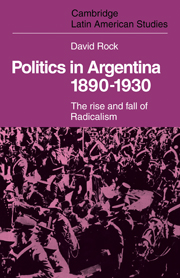Book contents
- Frontmatter
- Contents
- Preface
- 1 The components of Argentine society, 1890–1914
- 2 The oligarchy and institutional reform, 1880–1916
- 3 The rise of Radicalism, 1891–1916
- 4 The workers and their politics in Buenos Aires, 1890–1916
- 5 The first Radical government, 1916–22
- 6 The strikes, 1916–18
- 7 The Semana Trágica
- 8 1919
- 9 Postscript to the first presidency, 1920–2
- 10 The Alvear interlude, 1922–8
- 11 Yrigoyen's second presidency, 1928–30
- 12 Perspectives
- APPENDIXES
- 1 The occupational and class structure of the male population of the city of Buenos Aires by nationality, 1914
- 2 The rise of Radicalism – an historiographical note
- 3 The first Radical government and the Argentine Rural Society
- 4 The working class vote for the Radical and yrigoyenista parties in selected areas of Buenos Aires, 1912–30
- Select bibliography
- Index
2 - The oligarchy and institutional reform, 1880–1916
Published online by Cambridge University Press: 04 August 2010
- Frontmatter
- Contents
- Preface
- 1 The components of Argentine society, 1890–1914
- 2 The oligarchy and institutional reform, 1880–1916
- 3 The rise of Radicalism, 1891–1916
- 4 The workers and their politics in Buenos Aires, 1890–1916
- 5 The first Radical government, 1916–22
- 6 The strikes, 1916–18
- 7 The Semana Trágica
- 8 1919
- 9 Postscript to the first presidency, 1920–2
- 10 The Alvear interlude, 1922–8
- 11 Yrigoyen's second presidency, 1928–30
- 12 Perspectives
- APPENDIXES
- 1 The occupational and class structure of the male population of the city of Buenos Aires by nationality, 1914
- 2 The rise of Radicalism – an historiographical note
- 3 The first Radical government and the Argentine Rural Society
- 4 The working class vote for the Radical and yrigoyenista parties in selected areas of Buenos Aires, 1912–30
- Select bibliography
- Index
Summary
The term oligarchy refers both to the landed and commercial elite described in the last chapter and to the system of government which prevailed in Argentina up till 1912. The accuracy of the term is greater in the latter sense than in the former. It was certainly ‘government by a few’, though not always the same few were in power. To some extent power rotated among different factions, which represented different interests within the elite. Occasionally such differences were regionally based, at other times they were associated with specialised activities within the elite, for example, commerce, or the two main types of cattle-ranching: breeding and fattening. The term oligarchy is perhaps also misleading in that it suggests a complete homogeneity in the composition of the elite between different periods. This is more true of the period after 1900 than before.
The classic period of oligarchy as an institutional system was during the thirty years after 1880. The concern of the elite for control over the State was dictated by the role of the national government as a major source of credit and as a bridge for lucrative contacts with foreign capital. There was also great concern to maintain political stability, because, as events earlier in the nineteenth century had shown, stability was necessary for the attraction of both capital and labour into the country. The result of this was that the elite itself became very highly politicised, but at the same time it strove to keep other groups out of politics in order to minimise possible destabilising influences.
- Type
- Chapter
- Information
- Politics in Argentina, 1890–1930The Rise and Fall of Radicalism, pp. 25 - 40Publisher: Cambridge University PressPrint publication year: 1975

